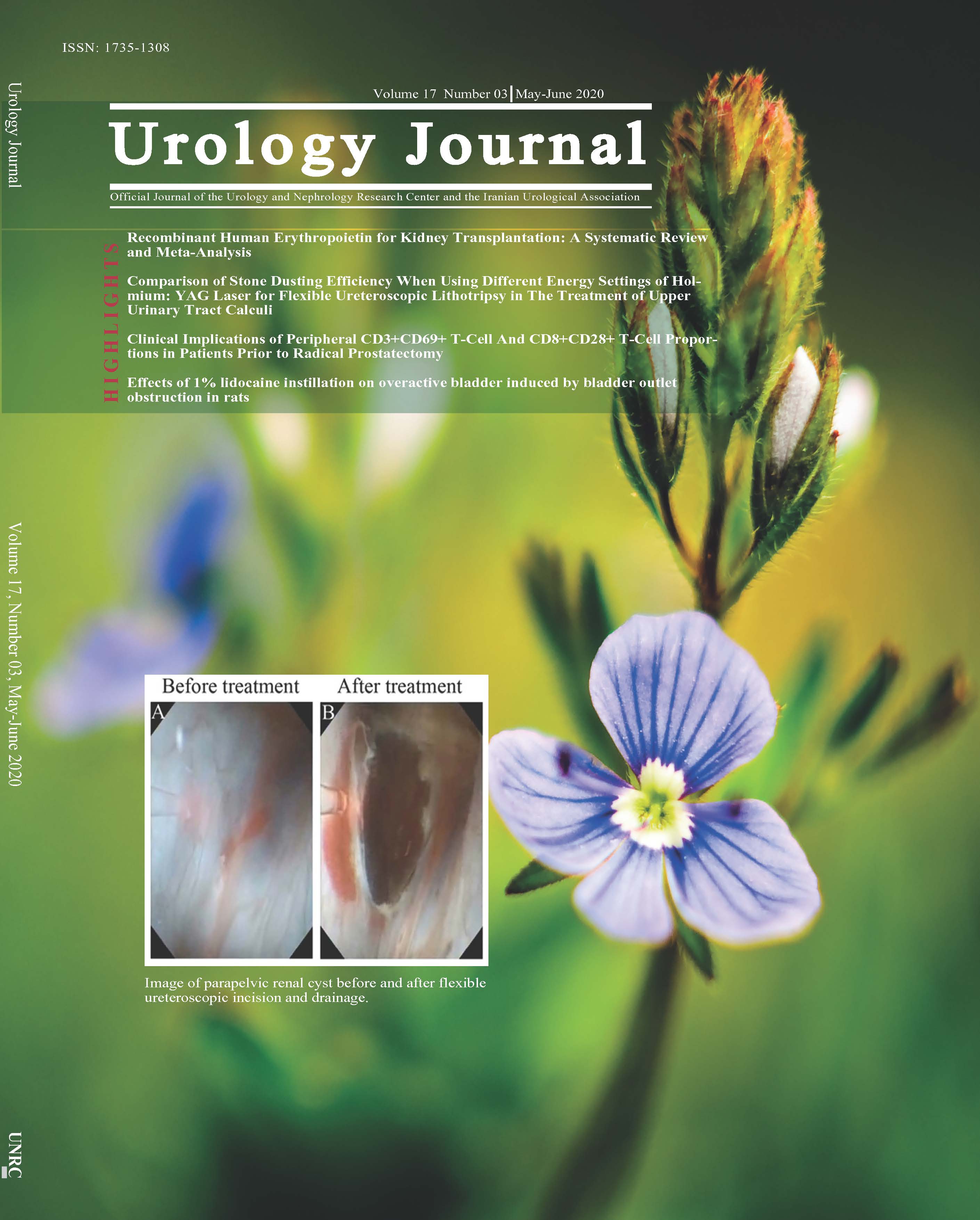Effects of 1% lidocaine instillation on overactive bladder induced by bladder outlet obstruction in rats
Urology Journal,
Vol. 17 No. 3 (2020),
16 Ordibehesht 2020
,
Page 306-311
https://doi.org/10.22037/uj.v17i3.5111
Abstract
Purpose:
Lidocaine is a common local anesthetic and antiarrhythmic drug that acts via the local anesthetic effect of blocking voltage-gated sodium channels in peripheral neurons. To evaluate lidocaine as a therapeutic agent, we investigated optimal concentrations and effects of intravesical lidocaine instillation in a bladder outlet obstruction (BOO)-induced rat model of overactive bladder (OAB).
Materials and Methods:
To determine the therapeutic dosage of lidocaine, 16 female Sprague-Dawley (SD) rats (mean weight = 200 ± 20 g) were divided into four treatment groups: those receiving saline, 0.5% lidocaine, 1% lidocaine, and 2% lidocaine (n = 4 per group). Twenty-four additional SD rats were divided into two groups to investigate the effect of 1% lidocaine treatment in rats with BOO and normal rats (n = 12 per group). Cystometry was performed by infusing physiological saline and lidocaine into the bladder at a slow infusion rate (0.04 mL/min). Cystometric parameters were analyzed using PowerLab®. The expression of c-Fos, a protein expressed by C-fibers in the spinal cord (L6), was investigated via western blotting.
Results:
Among the test lidocaine doses, only 1% lidocaine increased the intercontraction interval (ICI) (control mean = 500.56 ± 24.4 s; treatment mean = 641.0 ± 49.3 s; p < .01) without changes in threshold pressure and basal pressure. In the BOO-induced OAB group, the ICI increased significantly after instillation of 1% lidocaine (control mean = 135.8 ± 12.87 s; OAB-group mean = 274.2 ± 33.21 s; p < .01). Detrusor overactivity and non-voiding contraction were observed in the control group but not in rats with BOO after lidocaine instillation. The expression of c-Fos in C-fibers in the spinal cord (L6) decreased significantly after 1% lidocaine treatment in rats with BOO.
Conclusion:
Intravesical instillation of 1% lidocaine improves cystometric parameters without deterioration of contractility by blocking excessive C-fiber activity in the rat model of BOO-induced OAB. Therefore, instillation of 1% lidocaine has minimal effects on normal nerves while blocking nerves that contribute to OAB. Our findings suggest that intravesical instillation of 1% lidocaine is a useful treatment for OAB.How to Cite
References
Song M, Heo J, Chun JY, et al. The paracrine effects of mesenchymal stem cells stimulate the regeneration capacity of endogenous stem cells in the repair of a bladder-outlet-obstruction-induced overactive bladder. Stem Cells Dev. 2014;23:654-663.
Jun JH, Kang HJ, Jin MH, et al. Function of the Cold Receptor (TRPM8) Associated with Voiding Dysfunction in Bladder Outlet Obstruction in Rats. Int Neurourol J. 2012;16:69-76.
Rahnama'i MS, Van Koeveringe GA, Van Kerrebroeck PE. Overactive Bladder Syndrome and the Potential Role of Prostaglandins and Phosphodiesterases: An Introduction. Nephrourol Mon. 2013;5:934-945.
Lee WC, Chiang PH, Tain YL, Wu CC, Chuang YC. Sensory dysfunction of bladder mucosa and bladder oversensitivity in a rat model of metabolic syndrome. PLoS One. 2012;7:e45578.
Lee SR, Hong CH, Choi YD, Kim JH. Increased urinary nerve growth factor as a predictor of persistent detrusor overactivity after bladder outlet obstruction relief in a rat model. J Urol. 2010;183:2440-2444.
Cho KJ, Park EY, Kim HS, Koh JS, Kim JC. Expression of transient receptor potential vanilloid 4 and effects of ruthenium red on detrusor overactivity associated with bladder outlet obstruction in rats. World J Urol. 2013; doi:10.1007/s00345-013-1099-y.
Juszczak K, Ziomber A, Wyczolkowski M, Thor PJ. Urodynamic effects of the bladder C-fiber afferent activity modulation in chronic model of overactive bladder in rats. J Physiol Pharmacol. 2009;60:85-91.
Craig AD. How do you feel? Interoception: the sense of the physiological condition of the body. Nat Rev Neurosci. 2002;3:655-666.
Steers WD. Pathophysiology of overactive bladder and urge urinary incontinence. Rev Urol. 2002;4 Suppl 4:S7-S18.
Ragsdale DS, McPhee JC, Scheuer T, Catterall WA. Common molecular determinants of local anesthetic, antiarrhythmic, and anticonvulsant block of voltage-gated Na+ channels. Proc Natl Acad Sci U S A. 1996;93:9270-9275.
Yokoyama O, Komatsu K, Kodama K, Yotsuyanagi S, Niikura S, Namiki M. Diagnostic value of intravesical lidocaine for overactive bladder. J Urol. 2000;164:340-343.
Guerios SD, Wang ZY, Boldon K, Bushman W, Bjorling DE. Lidocaine prevents referred hyperalgesia associated with cystitis. Neurourol Urodyn. 2009;28:455-460.
Cummins TR. Setting up for the block: the mechanism underlying lidocaine's use-dependent inhibition of sodium channels. J Physiol. 2007;582:11.
Colaco MA, Evans RJ. Current recommendations for bladder instillation therapy in the treatment of interstitial cystitis/bladder pain syndrome. Curr Urol Rep. 2013;14:442-447.
Irwin DE, Milsom I, Kopp Z, Abrams P, Cardozo L. Impact of overactive bladder symptoms on employment, social interactions and emotional well-being in six European countries. BJU Int. 2006;97:96-100.
Silva C, Ribeiro MJ, Cruz F. The effect of intravesical resiniferatoxin in patients with idiopathic detrusor instability suggests that involuntary detrusor contractions are triggered by C-fiber input. J Urol. 2002;168:575-579.
Lazzeri M, Beneforti P, Turini D. Urodynamic effects of intravesical resiniferatoxin in humans: preliminary results in stable and unstable detrusor. J Urol. 1997;158:2093-2096.
Edlund C, Peeker R, Fall M. Lidocaine cystometry in the diagnosis of bladder overactivity. Neurourol Urodyn. 2001;20:147-155.
- Abstract Viewed: 369 times
- pdf/5111 Downloaded: 128 times
